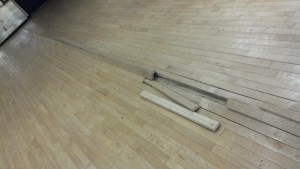It’s that season again. The one where heat and humidity have creeped up outside. That probably means that your air conditioner is working a lot harder, and your dehumidifier, if you have one, is as well. When you have a season like we have had in the East this year, where humidity and temperatures have been low most of the summer, and then suddenly spike way up into the 90’s, the additional strain on your air conditioner can make it slow or even break down. You aren’t alone in feeling the heat. Your Hardwood Floors are also likely feeling it, even if the signs haven’t started to show yet. 
That likely means that your hardwood floors have absorbed a lot of moisture as well. If the humidity in the rooms that have hardwood flooring in them has now gone above 65%, you may be experiencing some swelling and perhaps even some buckling of floors. Luckily, in most cases this is easily fixable.
Hardwood Floors and Humidity – Easier Than You Think
Unlike a nailed down floor, floors such as our Exterra and Zenterra are free floating. There are no nails or glue to hold it down to the subfloor. While this provides for a much more resilient floor, it also reacts to swings in moisture in a different way than a nailed floor, and that’s why we leave expansion gaps at the ends of the floor. This allows the floor to expand with the change in humidity, but once it hits the wall and the floor is continuing to take on more moisture, it has no more room to grow and so must start pushing up in the weakest part of the middle of the floor and can cause the floor to buckle.
The answer to humidity and wood floor issues? Dehumidification.
Using a dehumidifier proactively before buckling becomes a problem with your hardwood or gym floor is the best solution. Monitoring the humidity in rooms where you have hardwoods floors is your best way to prevent this, and even a very inexpensive humidistat can measure that for you enough to know when to start to take more aggressive action. Once the humidity starts inching up over 60%, it’s time to start employing dehumidifiers to get that level back down again.
When we think of dehumidifiers, we typically think of those where the water accumulates in a tray and then shuts off when the tray becomes full. Those aren’t the most effective dehumidifiers because of that safety shut-off. These can be easily neglected and so can go many days without anyone noticing that the dehumidifier is full. However, if you can monitor it regularly and that is all that is available, do not place the dehumidifier directly on the wood floor. It’s too easy to accidentally spill the contents of the tray onto the wood floor, or for the safety shutoff to fail and allow water to spill out, and this creates a bigger problem for you than just the presence of too much humidity in the room. Instead, put it in a doorway or some other area that is not right on top of the hardwood floor.
But a commercial humidifier is better to work with and better still if it is directly connected to your existing HVAC unit. The benefit of the commercial humidifier is not only that it can draw so much more moisture so much more quickly and do so over a larger space, but also that it allows for the moisture that is pulled out to be drained away. This eliminates the need for someone to monitor the tray and empty it on a regular basis. If the unit is hooked directly into the HVAC system, it can also be regulated more easily, running only when the humidity starts to sneak up above a set level.
If your hardwood floor is already starting to lift up in the middle, it’s not too late to save it, but you need to start really dehumidifying the room. It may take a few days, but once the humidity gets under control, you will find that the floor relaxes tight back down into place. However, before stopping dehumidification of the floor, lift up the baseboard at the ends of the floor and make sure that the wood floor is about ½” or more away from the wall so that the floor does not repeat the process once the humidity starts to rise again.
